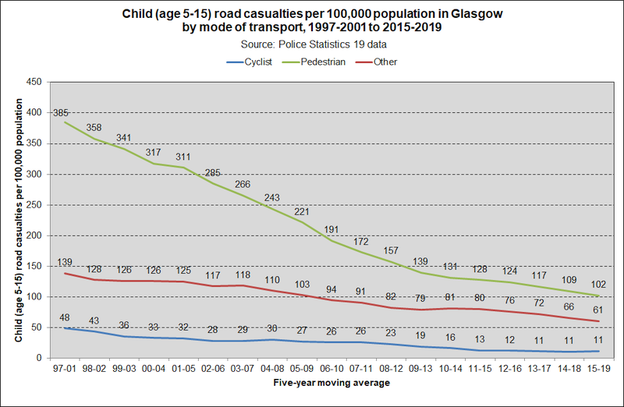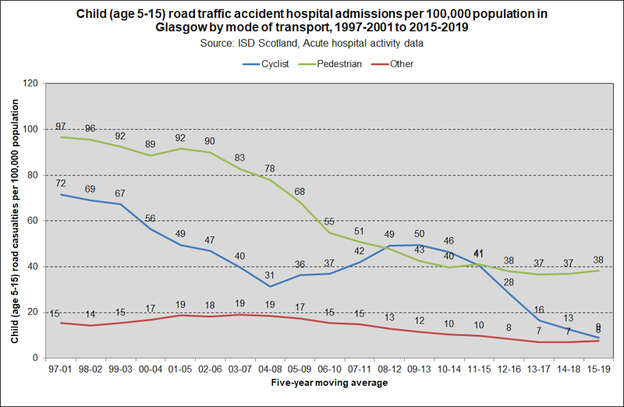Cyclists and pedestrians
Child (age 5-15) cyclist and pedestrian road casualties in Glasgow
Click on graph to enlarge
As expected, most child traffic accident casualties are pedestrians, although the rate of child pedestrian casualties has decreased dramatically since 1997-2001. Child casualty rates have decreased for cyclists and other forms of road use as well.
The casualty rates recorded by the police (via Stats 19) are higher than the rate of hospital admissions (shown below) for road traffic accidents. This reflects the fact that road accident casualties admitted to hospital represent a subset of all road accident casualties.
Child (age 5-15) cyclist and pedestrian road traffic accident hospital admissions in Glasgow
Click on graph to enlarge
The rate of child pedestrians being admitted to hospital due to a road traffic accident decreased sharply from 1997-2001 to 2012-2016, and has remained at roughly the same level. The rate of child cyclists being hospitalised decreased until 2004-08 when it, notably, began to increase again. The rate has since declined and has remained lower than that of child pedestrians since 2011-2015. These trends may reflect a change in the number of child cyclists, although many other factors from hospital recording practices to changes in road infrastructure may, potentially, be relevant.
More information on numbers of cyclists can be found in the cycling section of the website.
Notes
The figures shown are based on two sources:
Stats 19 statistical returns: made by police forces, which cover all accidents in which a vehicle is involved that occur on roads (including footways) and result in personal injury, if they become known to the police. There could be many non-fatal injury accidents which are not reported by the public to the police, and are therefore not counted in these statistics. Further statistics on Stats 19 based road traffic accidents and casualties can be accessed from Transport Scotland publications.
Hospital admission data: These statistics are derived from data collected on discharges from non-obstetric and non-psychiatric acute hospitals (SMR01) in Scotland. The data are based on year of discharge. Relevant hospital episodes have been identified by admission type (emergency hospital admission: SMR01 admission type code 32 - Patient injury - road traffic accident) and by diagnosis (Pedestrian injured in transport accident (V01-V09), Pedal cyclist injured in transport accident (V10-V19), Motorcycle rider injured in transport accident (V20-V29), Car occupant injured in transport accident (V40-V49), Other (any other diagnosis codes recorded)).
New publication:
In February 2020, the Glasgow Centre for Population Health and Cycling Scotland jointly published Cycling in Scotland: a review of cycling casualties, near misses and under-reporting. This report combines analysis of reported cycling casualties in Scotland over a 23-year period from 1995-2018 alongside a literature review of under-reporting and near misses. The main findings were: the rate of serious injuries and fatalities in Scotland increased by 18% between 2004-2018; the majority (84%) of cycling casualties involved a collision with a car; one-in-ten cycling casualties were victims of hit and run incidents and pedestrian injuries caused by a collision with a cyclist were rare.
Additional Resources
-
ResourceThursday, 6 December 2012
Going to Gothenburg: Reflections on a Study Visit
-
ResourceWednesday, 18 May 2011
Hands Up Scotland 2010
Results from the largest national dataset to look at mode of travel to school across Scotland -
ResourceFriday, 1 October 2010
Moving in the right direction?
Findings from a review of transport policy in Scotland -
ResourceSaturday, 21 August 2010
Active Travel - Video
Qualitative research has been undertaken in order to better understand how and why people currently travel as they do and to explore the scope for encouraging growth in alternatives to car travel. -
ResourceTuesday, 1 September 2009
Attitudes toward active travel in Glasgow
Findings from a qualitative research project exploring how and why people travel in and around Glasgow -
ResourceThursday, 1 November 2007
How can transport contribute to public health?
A briefing paper discussing the evidence regarding the potential of transport to improve health, reduce inequalities and improve sustainability









